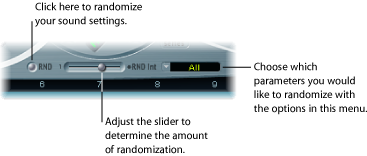Creating Random ES2 Sound Variations
The ES2 offers a unique feature that allows you to randomly vary the sound parameters. You can define the amount of random variation and restrict variations to specific sonic elements. The random sound variation feature will inspire and aid you when creating new sounds. It may also occasionally amuse you.

Click the RND button below the Filter section.
The process is triggered by a single click and can be repeated as often as you like.
Note: This feature has nothing to do with random real-time modulations. The random feature changes parameter values randomly—each time you click the RND button. Real-time random modulations are achieved with the random LFO waveforms, or through use of the Analog parameter, which randomizes pitch settings.
Tip: It’s recommended that you save any sounds resulting from the RND process that you want to keep—as you work. Save the setting with a new name—using the Settings menu of the plug-in window.
Defining the Amount of Randomization in the ES2
You can set the amount of random parameter alteration with the RND Int slider, found to the right of the Random button.
Move the slider further to the right.
The random sound variation feature always alters parameters as they are currently set, not based on the original setting file. Therefore, clicking RND repeatedly will result in a sound that increasingly differs from the original setting.
Reload the original setting after each random alteration, saving each with a new name if desired.
Restricting Randomization to ES2 Parameter Groups
Some aspects of your sound may already be ideal for the sound you had in mind. If so, it may not be desirable to alter them. For example, if your sound setting has a nice percussiveness, and you’d like to try a few sonic color variations—while retaining this percussive feel. To avoid the random variation of any attack times, you can restrict the variation to oscillator or filter parameters. You do this by setting the RND Destination to Waves or Filters, thus excluding the envelope parameters from the variation process.
Note: The Master Level, Filter Bypass, and Oscillator On/Off parameters are never randomized. Also, randomizations of the Vector Envelope turn the Solo Point parameter off.
You can restrict random sound variations to the parameter groups listed below:
Parameter group | Comments |
|---|---|
All | All parameters, with the exception of those mentioned above, are randomized. |
All except router and Pitch | All parameters, with the exception of router parameters and the basic pitch (semitone settings of the oscillators), are altered. Oscillator fine-tuning is, however, randomized. |
All except Vector Env | All parameters, with the exception of Vector Envelope parameters, are altered. This maintains the rhythmic feel of a given setting. |
Waves | Only the oscillator Wave and Digiwave parameters are altered. Other oscillator parameters (tuning, mix, and modulation routings in the router) are excluded. |
DigiWaves | New Digiwaves are selected for all oscillators. Other oscillator parameters (tuning, mix, and modulation routings in the router) are excluded. |
Filters | The following filter parameters are varied: Filter Structure (series or parallel), Filter Blend, Filter Mode, Cutoff Frequency, and Resonance for Filters 1 and 2. The Fatness and Filter FM parameters of Filter 2 are also randomized. |
Envs | All parameters of all three envelopes (ENV 1, ENV 2 and ENV 3) are randomized. The Vector Envelope is excluded. |
LFOs | All parameters of both LFOs are varied. |
Router | All router parameters—in all modulation routings—are varied (all intensities, target, via, and source parameters are changed). |
FX | All effects parameters are randomized. |
Vector Envelope | All Vector Envelope parameters are varied, including the X/Y routing of the Planar Pad. |
Vector Env Mix Pad | The oscillator mix levels (Triangle square icon positions) of the Vector Envelope points are altered. The rhythm and tempo of the modulation (the time parameters of the points) are not changed. |
Vector Env XY Pad Options | The Planar Pad square icon positions (the Vector Envelope points) are randomized. The X/Y routing, however, is not changed. The rhythm and tempo of the modulation (the time parameters of the points) are also left unaltered.
You can specify a single direction for randomization by choosing either:
|
Vec Env Times | Only the time parameters of the Vector Envelope points are altered. |
Vec Env Structure | The Vector Envelope structure is altered. This includes: All times, the Sustain point, the number of points, and all loop parameters. |
Vec Env Shuffle Times | The Vector Envelope shuffle times (within loops) are altered: This includes the Loop Smooth value, if Loop Mode is set to Forward or Backward. |